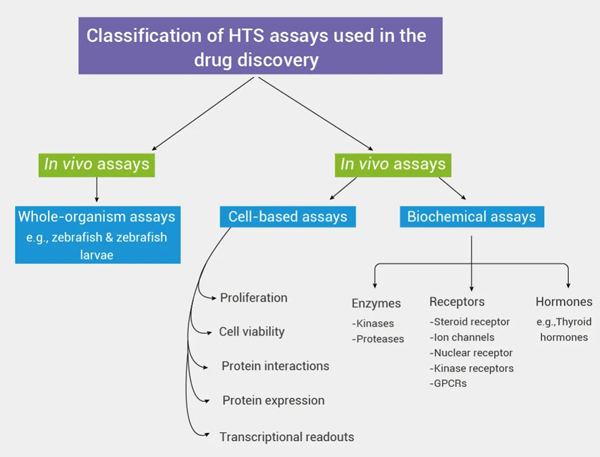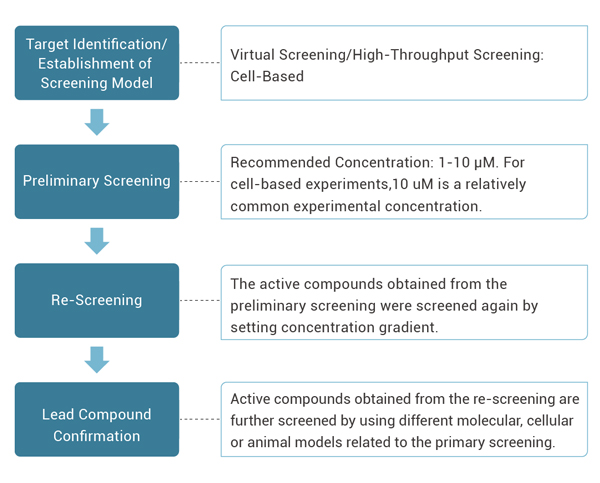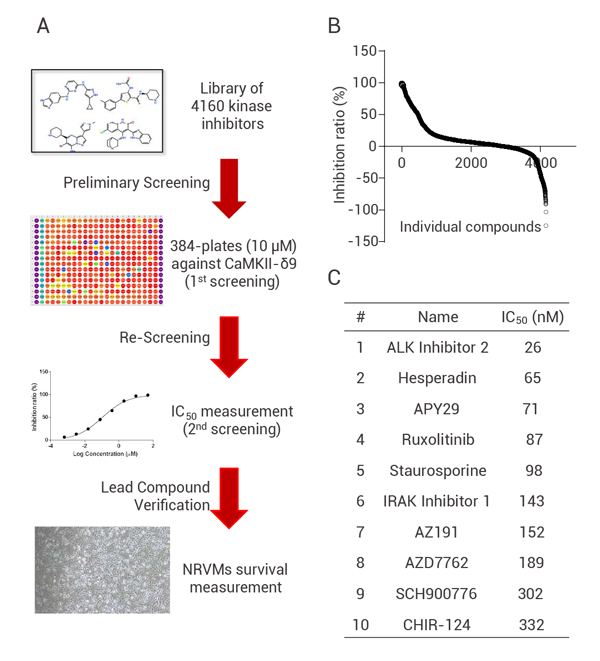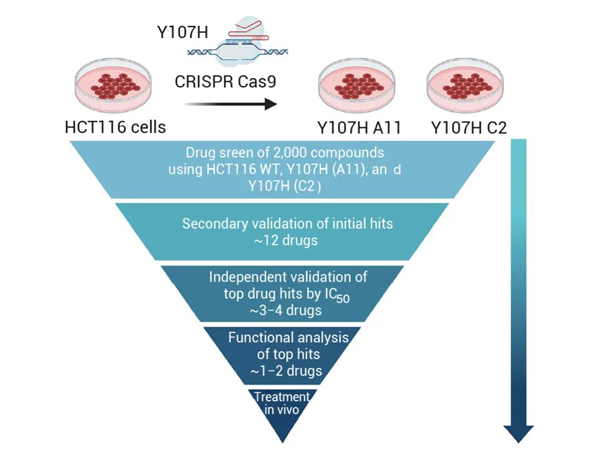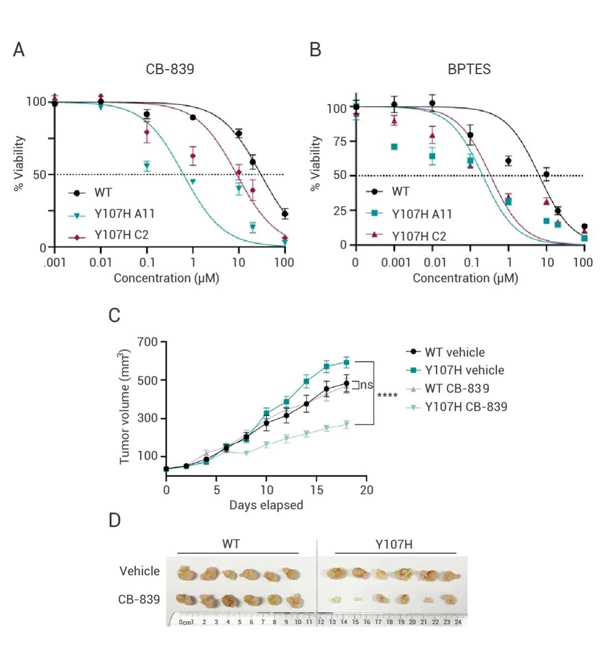Compound Screening Guide!
High-Throughput Screening Accelerates Drug Discovery
Drug discovery is a long-term and high-cost process, which is roughly divided into several parts such as early drug development, preclinical research stage, clinical research stage, and approval for listing. Early drug development is a key process in the development of new drugs, including the study of disease mechanism, target discovery and confirmation, and the discovery of lead compounds[1].
High-Throughput Screening (HTS) is one of the commonly used techniques in drug discovery, which is used to find out potential lead compounds for pharmacochemical optimization from compound libraries, greatly speeding up the process of high-volume compound screening.
Using automated rapid testing of thousands to millions of samples, HTS can verify biological activity at the model organism, cell, or molecular level, screening for small molecular compounds, chemical mixtures, natural products, oligonucleotides, and antibodies with known structures[2][3].
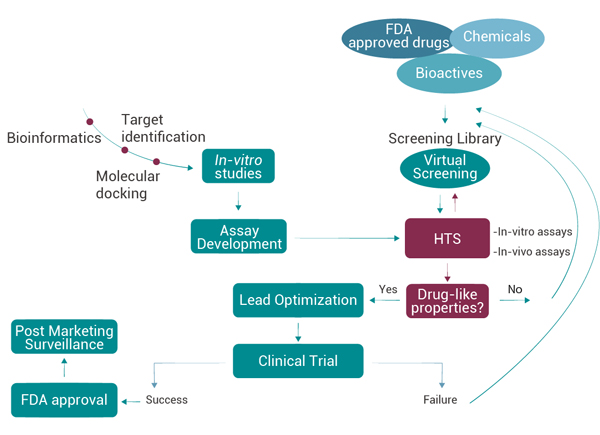
Fig 1. Steps involved in the process of drug discovery[4].
How to Choose a Suitable Library?
If there is a clear target, pathway or disease, it is recommended to select the corresponding compound library. If there are specific protein names and structures associated with clear pathways, virtual screening can be used for preliminary screening, and then purchase corresponding physical compounds based on the results of virtual screening.
In addition, MCE can also help customers to screen and match the compounds that according to specific experiments.
Figu 2. Information for a customized library.
How to Use Compound Library for Screening Experiments?
Screening based on compound library mainly includes experimental design, drug screening, data analysis, lead compound confirmation and other processes.
• Type of Screening Experiments
As shown in Figure 3, there are many methods for HTS experimental screening, including cell-based experiments, biochemical experiments, and experiments on simple organisms in vivo (zebrafish, etc.).
More commonly used is cell-based screening, which can provide data that cannot be obtained from biochemical assays, such as whether a compound has pharmacological activity at a specific receptor or intracellular target. Cell-based screening therefore holds particular promise as an important tool for studying cell growth and differentiation, examining the effects of small molecules and cell growth conditions on cell function and physiology, and understanding mammalian cell signaling pathways[3].
Fig 3. General classification of HTS methods[4].
• Screening Procedures of Cell-Based Screening Experiments
1) Preliminary Screening
Cell viability/proliferation assay is one of the commonly used experiments, and it is recommended to screen with a single concentration. 10 μM is commonly used for screening (If the cells can tolerate higher DMSO content, the primary screening concentration can also be increased to 30/50 μM). Compare the inhibition/activation rate or screen out positive compounds based on the activity data and number of compounds screened (The lower the concentration of compounds used in the initial screening, the fewer compounds screened and the higher the relative activity).
2) Re-Screening
The positive compounds obtained from the preliminary screening were re-screened with different concentrations. It is recommended to set 6-7 concentrations, and the dilution range should be higher than four orders of magnitude. The maximum concentration can be set by referring to the DMSO tolerance test data, generally no more than 100 μM, and at least 3 replicates should be set for each concentration.
The best active compound is selected by screening results, which excluded false positive compounds and no concentration dependent compounds.
3) Validation of Lead/Hit Compounds
Because each detection method has certain limitations, for the lead compounds obtained from the preliminary screening or re-screening, further verification analysis needs to be performed by using different detection methods than the primary screening and re-screening to rule out false positives.
Note: The experiment should be set up negative control, positive control (if any) and blank control.
Fig4. Cell-based HTS process.
The following are two customer publications using MCE compound libraries, and the screening procedures in the literature can be used as experimental reference.
Case 1
• Circulation. 2022 Apr 12;145(15):1154-1168. IF=37.8
In this article, The customer used a Kinase Inhibitor Library (HY-L009) and a high-throughput system for the kinase activity assay of CaMKII-δ9, the most abundant CaMKIl-δ splicing variant in the human heart, to screen and validate a highly active and selective CaMKIl-δ small molecule inhibitor Hesperadin is a lead compound with dual functions of cardiac protection and antitumor activity.
Fig 5. Screening process of CaMKIl-δ inhibitors[5].
(A) High-throughput screening process; (B) Inhibitory rate of 4,160 compounds on CaMKII-δ9 kinase activity; (C) List of the top 10 compounds with the lowest IC50 inhibiting CaMKII-δ9 kinase activity in rescreening.
Preliminary screening: A screening system was first established using the recombinant CaMKII-δ9 protein to test the inhibition of an inhibitor library of 4,160 compounds (partially purchased from MCE), with KN93 as a positive control (Figures 5A and 5B). At a concentration of 10 μM, 33 molecules inhibited the activity of CaMKII-δ9 by more than 95%.
Re-screening: The 33 molecules obtained in the preliminary screening were tested for IC50 which inhibited the activity of CaMKII-δ9 kinase.
Verification of lead compounds: On the basis of re-screening, the top 10 compounds with the lowest IC50 were selected (FIG. 5C) to further analyze the protective effects on cardiomyocytes.
Finally, the team screened Hesperadin, an Aurora B kinase inhibitor with anti-tumor activity, in vitro, which could specifically inhibit CaMKII-δ in the heart in an ATP-competitive manner. In addition, in BALB/c nude mouse models implanted with human cancer cells in vivo, Hesperadin delayed tumor growth but did not cause cardiomyocyte death or heart damage (Figure 6).
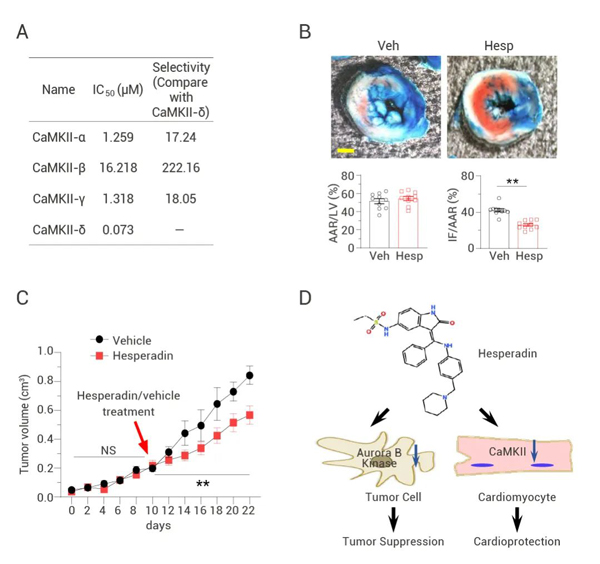
Fig 6. Experimental verification of Hesperadin, an Aurora B kinase inhibitor with anti-tumor activity[5].
(A) IC50 value and kinase selectivity of Hesperadin to CaMKII subtype; (B) Hesperadin significantly decreased the size of I/ R-induced myocardial infarction; (C) Hesperadin significantly inhibited tumor growth; (D) Dual function of Hesperadin in heart and tumor.
Case 2
• Cancer Discov. 2023 Jul 7;13(7):1696-1719. IF=28.2
Y107H, a mutant of tumor suppressor gene TP53, can increase the risk of cancer in mice. The authors selected 2,000+ compounds from the MCE anti-cancer compound library (HY-L025) through primary screening and secondary screening. To obtain compounds that induce Y107H mutated HCT116 colorectal cancer cells (clonal A11 and C2) to preferentially deactivate, and to explore the potential mechanism of Y107H's action in colon cancer.
Fig 7. Schematic diagram of compound screening to enhance the loss of cell viability in colorectal cancer with Y107H mutation[6].
Validation of candidate compounds: Two of the screened compounds, the glutaminase inhibitors
CB-839 and
BPTES , showed increased sensitivity in Y107H mutated colorectal cancer cells treated with two candidate compounds using independent cell viability assays (Alamar Blue) (Figures 8A and 8B). CB-839 (200 mg/kg) can significantly inhibit tumor growth in NSG mice (Y107H cell group).
Fig 8. Validation of CB-839 in Y107H mutant colorectal cancer cells and mice[6].
(A-B) 72-hour IC50 analysis of colorectal cancer cells treated with Y107H mutation by CB-839 or BPTES; (C-D) Effect of CB-839 on tumor growth in NSG mice with WT p53 or Y107H clonal A11.
The lead compound is obtained, and the structure can be further optimized to promote the better function of the drug.
MCE Compound Library
As a leading global supplier of research chemicals and bioactive compounds, MCE currently offers a library of 200+ ready-to-use active compounds, totaling 20,000+ bioactive small molecules for high-throughput screening (HTS) and high content screening (HCS). It is a professional tool for research on new drug screening and new indication discovery!
• Bioactive Compound Libraries
Bioactive compounds are easy to penetrate the cell membrane, act on specific target proteins in cells, regulate intracellular signaling pathways, and then cause some changes in cell phenotype. MCE provides 20,000+ compounds with clear reports, known activities and clear targets. All products in the compound library target comprehensive targets, involving a wide range of signaling pathways, can be used for signaling pathway research and new drug development.
• Drug Repurposing Compound Libraries
New drug discovery is a time-consuming and high-cost process, a large number of potential drugs never enter clinical testing, and even when compounds do enter clinical development, less than 15% are ultimately approved, so drug repurposing is attractive and pragmatic[7]. Approved drugs and compounds through clinical phase I have good biological activity, pharmacokinetic properties and safety, which can reduce the risk of drug development failure, shorten the research and development cycle, and reduce research and development costs. The MCE includes 5,000+ drugs that are suitable for study in new indications.
• Natural Product Libraries
Natural products are produced in nature, including primary metabolites and secondary metabolites. Natural products and their derivatives still make up a large proportion of approved drugs globally, but as shown in Figure 9, natural products may be underutilized in high-throughput screening[8]. Therefore, the biodiversity and potential biological activity of natural products are important sources for the development of lead compounds in drug discovery. MCE contains 5,000+ natural products with rich sources and diverse structures, and is an important source of lead compounds.
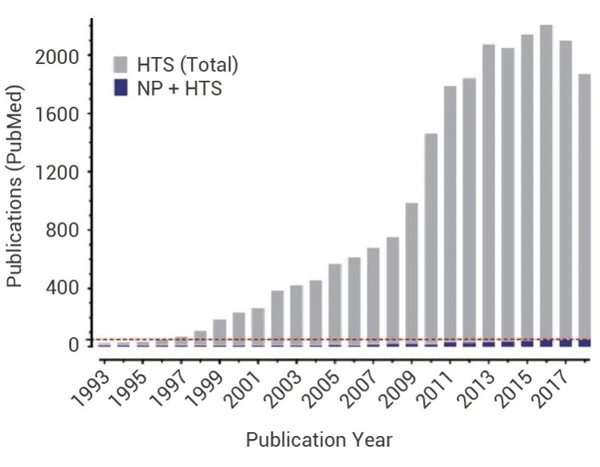
Fig 9. Comparison of the number of publications for "natural products and high-throughput Screening (NP+HTS)" or "high -throughput screening alone (HTS)"[8].
• Traditional Chinese Medicine Active Compound Libraries
As the cornerstone of traditional Chinese medicine, Chinese herbal ingredients have a wide variety of chemical structures and high selectivity, and are considered to be the ideal starting point for molecular design. It is estimated that no less than 50% of small molecule clinical drugs approved worldwide are derived directly or indirectly from herbal ingredients[9]. TCM monomer is the active ingredient in Chinese herbal medicine, which has many medicinal properties, such as antioxidant, anticancer, antibacterial and so on, and is an important source of new drug development. The MCE contains 3,000+ monomer compounds of Chinese herbal origin and is a useful tool for screening medicines of Chinese herbal origin.
• Fragment Compound Libraries
Fragment-based drug development (FBDD) usually starts with chemical fragments with low binding affinity to the target, low chemical structure complexity, and low molecular weight (≤300 Da), which is very suitable for the discovery of lead compounds and functional probes. Fragment compounds can cover a wide chemical space, save experimental costs, and provide diversified hits[10]. MCE included 22,000+ fragments of compounds, all in line with the "RO3 principle", that is, molecular weight ≤300 Da, hydrogen donors ≤3, hydrogen acceptors ≤3, cLogP≤3.
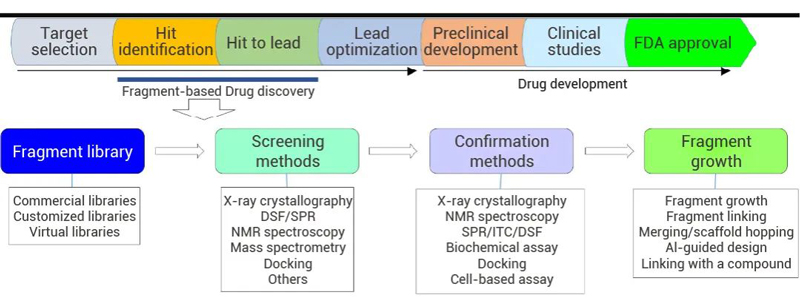
Fig 10. Target-based drug discovery steps and FBDD flow chart[10].
MCE has been helping global customers with scientific research, so far, MCE has known activity library, drug diversity library, characteristic fragment library and drug screening, lead compound optimization platform, providing one-stop drug discovery and research services for global scientific research customers and new drug research and development customers. If you have any needs, please contact us anytime.
References
[1] J P Hughes, et al. Principles of early drug discovery. Br J Pharmacol. 2011 Mar;162(6):1239-49.[2] Michael Entzeroth, et al. Overview of high-throughput screening. Curr Protoc Pharmacol. 2009 Mar;Chapter 9:Unit 9.4.[3] Paweł Szymański, et al. Adaptation of High-Throughput Screening in Drug Discovery-Toxicological Screening Tests. Int J Mol Sci. 2012; 13(1): 427–452.[4] Hasan Aldewachi, et al. High-Throughput Screening Platforms in the Discovery of Novel Drugs for Neurodegenerative Diseases. Bioengineering (Basel). 2021 Feb 23;8(2):30. [5] Junxia Zhang, et al. Novel CaMKII-δ Inhibitor Hesperadin Exerts Dual Functions to Ameliorate Cardiac Ischemia/Reperfusion Injury and Inhibit Tumor Growth. Circulation. 2022 Apr 12;145(15):1154-1168.[6] Alexandra Indeglia, et al. An African-Specific Variant of TP53 Reveals PADI4 as a Regulator of p53-Mediated Tumor Suppression. Cancer Discov. 2023 Jul 7;13(7):1696-1719.[7] Steven M Corsello, et al. The Drug Repurposing Hub: a next-generation drug library and information resource. Nat Med. 2017 Apr 7;23(4):405-408.[8] Brice A P Wilson, et al. Creating and screening natural product libraries. Nat Prod Rep. 2020 Jul 1;37(7):893-918.[9] Liu-Xia Zhang, et al. TCMSID: a simplified integrated database for drug discovery from traditional chinese medicine. J Cheminform. 2022 Dec 31;14(1):89.[10] Qingxin Li, et al. Application of Fragment-Based Drug Discovery to Versatile Targets. Front Mol Biosci. 2020 Aug 5;7:180. 







